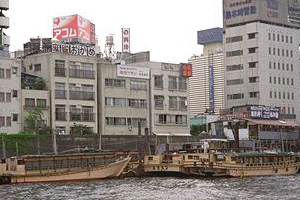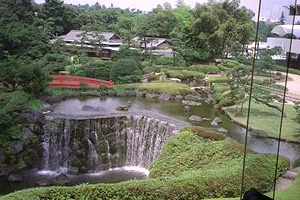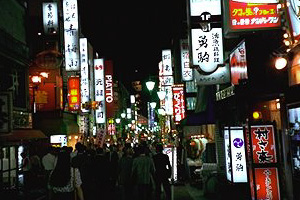
Bruce "Tog" Tognazzini.
|
|
Japan on $1000 per Day
Day 1: Sticker Shock[Don't let the title scare you, at least not too much. Japan can be very expensive, but you can travel the country and see all the important sights at a fraction of the cost we paid. We were on an expense account for the first half and were really "living it up" for the second. Read on for a detailed and interesting itinerary that can be followed no matter your budget.] Japan stands out. Usually, in travel, you face the choice of either visiting a country that is exotic, but less than sanitary, or a clean country replete with only the comforts of home. Comforts like Macdonald's, The Gap, and Kentucky Fried Chicken, the same dull, boring comforts that drove you to travel in the first place. Japan offers the ideal, a combination of the truly exotic and the truly sanitary. Struck with a powerful case of Japanophelia a few years ago, my wife and I took out a second mortgage on our house, sold off the livestock, and headed for the airport. Over the next two weeks, we would eat poisonous fish, sleep at mountain inns, and travel the length of Japan's main island, leaving a trail of hundred dollar bills like Hansel and Gretel's trail of bread crumbs. Things are better now. The bloom is off the booming Japanese economy, and, on our last trip, we found food and lodging priced at 40% and even 50% below the prices you will read here. One can, of course, stay at a reasonably priced hotel, instead of purposely seeking out the most expensive hotel in the world. We splurged. After all, this was to be a "once in a lifetime experience." That didn't work out because we loved it so much that "once in a lifetime" has turned into "every excuse we can get. Still, our original itinerary proved ideal for a first trip. Select lodging in keeping with your own level of sanity and budget and you can follow in our footsteps on a fraction of the prices listed here. A Brief HistoryJapan was settled a whole bunch of years ago by some people from the East. For centuries, they lived in harmony, but trouble was brewing. In the early years of the fifteenth century, the Scots, having made wee skirts for every man in the country, were casting about for additional outlets for brightly-colored, funny-looking clothes. The result was the invention of Golf. It took some years, but by the turn of the twentieth century, Golf had made its way east to Japan, where it soon displaced other hobbies such as archery, ceramics, wood carving, fishing, working, living, and breathing. While, historically, the Japanese islands had been given over to rice farming, forest, and housing, the mix quickly shifted to golf courses, additional golf courses, and caddyshacks. By the mid-1930s, the Japanese had run out of golf courses. They looked elsewhere, found prime golfing sites, and took them. None of the world powers made too much noise about it until the fateful day a bunch of Mitsubishi bomber planes drifted off course while attempting to capture Honolulu Municipal Golf Course and managed, instead, to sink half the Pacific Fleet. A bit of a melee ensued, with a few million people killed on each side, and the Japanese eventually had to surrender and temporarily take up table tennis. Soon, however, the Japanese came up with a new plan. They invented what we now know as "Japanese cars." When they sent them to America, the friendly folks in the USA bought them in droves. As the money rolled in, the turf rolled out. By the mid-1990s, from the suburbs of Tokyo to the fairways of Pebble Beach, California, the Japanese were driving and putting their way across half the world. All this is background to explain the strange sight that met us as we caught the first glimpse of our goal, the first wave of driving ranges, a sight that would become all too familiar. Perhaps I've exaggerated just a bit, but the Japanese have given over enormous tracts of land to golf, and their practice ranges indeed herald your advance onto the main island. The Japanese practice ranges aren't like ours, either. Most are hi-rises, stretching anywhere from three to six stories in the air. (I'm told you can get quite a loft on the ball if you start out 60 feet up.) And they are the most constant feature of the Japanese landscape. We stood few places in Japan where you could not see at least one practice range, and often you could see two or three. In the country, they announce every little town or village. In the city, they announce each change in neighborhood. The reason for the ranges is simple. Golf is wildly expensive in Japan, with greens fees for a single round approaching $1500 US. The prices are so high that it's cheaper to fly to Hawaii, stay overnight, play a round of golf, and fly home, than it is to play a single round at your local course. And now back to our exciting adventure...Day 1. Japan at last! Here we are at Narita Airport, ready to strike out for what we assume is the short trip into Tokyo! Day 5: The Samurai climbed a nearby hill today. He claims to have seen Tokyo far away in the distance, just over that next practice range. Many feel we will reach it within the month, although I do not share their optimism. We are low on food and water. The children now cry almost constantly.... Day 1 (ctnd): Perhaps I have exaggerated again. It is actually a two-hour bus ride into town, plus a half-hour taxi ride to the hotel through traffic that has not moved since early 1963. Tokyo looks like the inventor of the Lava Light was elected city planner many, many years ago.
The city is an explosion of cheap neon signs and cheaper architecture, punctuated far too seldomly by those buildings of quiet grace and beauty we have come to think of as all Japan. The taxi crossed a bridge that would be a rival for the Pont de Neuf in Paris, except they later slid over the top of it,. with scant 15 feet to spare, the ugliest looking skyway I have ever seen, casting the bridge into a deep, permanent gloom. We begin our stay in the New Otani, not to be confused with the Old Otani, on account of there doesn’t seem to have been an Old Otani. We are in the tower, a modern concrete sculpture reminiscent of a very expensive washing machine agitator. ("Very expensive" is a modifier we will quickly learn to attach to every noun that comes along--talk about sticker shock!) Our room overlooks the 600 year-old garden that forms the grounds of the hotel, then across the moat to the royal palace where various princes and princesses live. (We will later invite them up for cocktails, only to discover they are off cutting a ribbon somewhere.)
As I stood gazing out at the beauty spread before me, my wife, the Doctor, suddenly swooned. I spun just in time to catch what was in her hand as she thumped to the floor. The dear child had been holding the room service menu. When I saw the prices (very expensive), I joined her on the floor. A side order of spaghetti was $38 US. Sauce extra. An 8 ounce sirloin steak? $130, but that included a dinner salad. We went out to eat. Followed the neon glow northward into a narrow street filled with bars, discos, and very expensive "cheap" restaurants.
Julie had the Chicken Tepanyaki, consisting of raw chicken you cook yourself on a small grill at the table, thus saving on the cost of labor, while I had some funny looking green stuff I saw in a photo on the menu. It turned out to be—I am not making this up—chili rellenos. The chilis were smaller than the Mexican-American version, but the taste was identical. Next: Day 2: Among the Dead and Dying (Fish) |


